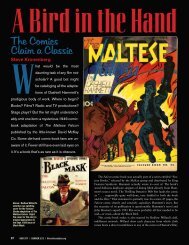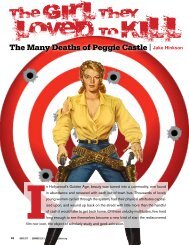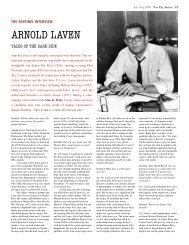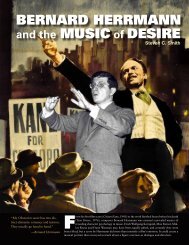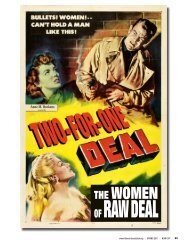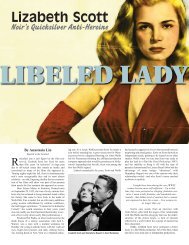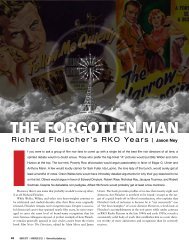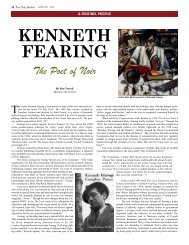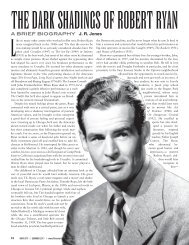Crane Wilbur - Film Noir Foundation
Crane Wilbur - Film Noir Foundation
Crane Wilbur - Film Noir Foundation
You also want an ePaper? Increase the reach of your titles
YUMPU automatically turns print PDFs into web optimized ePapers that Google loves.
In only his third movie, 26-year-old John Garfield starred in Blackwell’s Island (Warner Bros.,1939), from a story and screenplay by <strong>Crane</strong> <strong>Wilbur</strong><br />
already had both a taste for the macabre and an interest in the inner<br />
workings and methodology of criminal organizations.<br />
While the 20-something <strong>Wilbur</strong> acted on Broadway and in stock,<br />
he also continued to hone his writing craft. A 1909 review of <strong>Wilbur</strong>’s<br />
musical-comedy-drama Fritz the Wandering Musician said the four-act<br />
play by the “rising young playwright,” was “…clean, clever and bright,<br />
and holds the interest of the audience from the rise of the curtain until<br />
its final fall on the last act.” However, it was as an actor, not a writer,<br />
that the handsome <strong>Crane</strong> <strong>Wilbur</strong> made his motion picture debut in the<br />
summer of 1911, with the American Pathé company of New Jersey. <strong>Wilbur</strong><br />
soon proved a capable leading man, although he claimed to never<br />
be that impressed with his own acting skills. At Pathé, <strong>Wilbur</strong> teamed<br />
up with actress Pearl White for a number of short films prior to their<br />
breakthrough with The Perils of Pauline, which put <strong>Wilbur</strong> briefly into<br />
the realm of top mid-teens leading men. For his part as hero in a series of<br />
death-defying escapes (and hands-on work with live rattlesnakes, lions<br />
and rats), <strong>Wilbur</strong> made about $125 per week—a decent salary for 1914,<br />
if not on Chaplin or Pickford levels.<br />
In 1915, the Lubin company of Philadelphia lured <strong>Crane</strong> <strong>Wilbur</strong><br />
away from Pathé to make the serial The Road of Strife. Later that<br />
same year, <strong>Wilbur</strong> headed west to California to work at David Horsley’s<br />
Centaur studios, where in 1916 he began making feature-length<br />
52 noir citY i SPrinG 2011 i www.filmnoirfoundation.org<br />
productions—which he soon began writing and directing, as well.<br />
However, still less than sanguine about his own acting skills—and<br />
about motion pictures in general—<strong>Wilbur</strong> relocated to Oakland,<br />
California, in 1918, to operate his own theater and set up a film<br />
studio. During this period he experienced more personal pain. His<br />
22-year-old second wife, Arleene Archibald, died in 1916, and three<br />
years later his infant son (by third wife Florence Dunbar) suffocated<br />
in his sleep. Fleeing the devastation, <strong>Crane</strong> <strong>Wilbur</strong> abandoned filmmaking<br />
in 1920 and relocated to New York, to again work as a stage<br />
actor and playwright.<br />
The Mysteries Begin<br />
<strong>Wilbur</strong>’s first Broadway offering as a playwright, 1920’s The<br />
Ouija Board, was a murder mystery set against the backdrop of<br />
bunko spiritual mediums. Though only a modest success, it paved<br />
the way for a 1922 <strong>Wilbur</strong>-penned follow-up called The Monster,<br />
which featured a mix of humor, mystery, and horror. Set in an insane<br />
asylum, The Monster ran for over 100 performances, and was optioned<br />
by producer-director Roland West for a 1925 movie version<br />
starring Lon Chaney.<br />
Through the rest of the ’20s, <strong>Wilbur</strong> continued on Broadway, balancing<br />
acting with the production of his plays, such as the comedy



